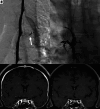Spinal CSF Leaks: The Neuroradiologist Transforming Care
- PMID: 39209484
- PMCID: PMC11543077
- DOI: 10.3174/ajnr.A8484
Spinal CSF Leaks: The Neuroradiologist Transforming Care
Abstract
Spinal CSF leak care has evolved during the past several years due to pivotal advances in its diagnosis and treatment. To the reader of the American Journal of Neuroradiology (AJNR), it has been impossible to miss the exponential increase in groundbreaking research on spinal CSF leaks and spontaneous intracranial hypotension (SIH). While many clinical specialties have contributed to these successes, the neuroradiologist has been instrumental in driving this transformation due to innovations in noninvasive imaging, novel myelographic techniques, and image-guided therapies. In this editorial, we will delve into the exciting advancements in spinal CSF leak diagnosis and treatment and celebrate the vital role of the neuroradiologist at the forefront of this revolution, with particular attention paid to CSF leak-related work published in the AJNR.
© 2024 by American Journal of Neuroradiology.
Figures








References
Publication types
MeSH terms
LinkOut - more resources
Full Text Sources
Miscellaneous
